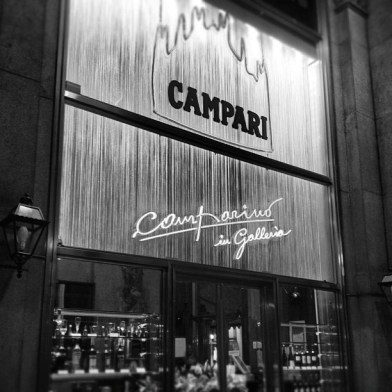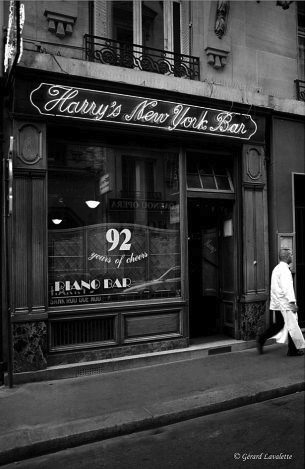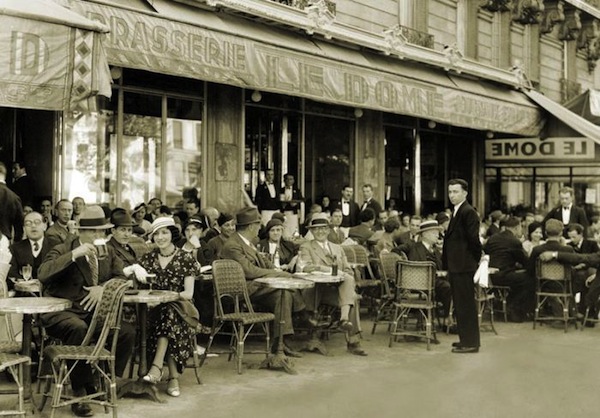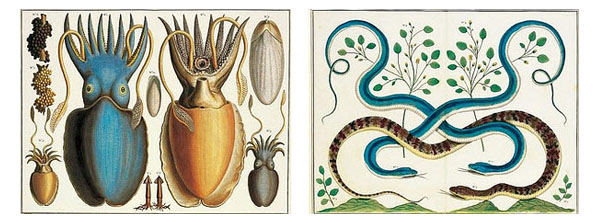A Measure of History: Aperitifs To Write Home About
“Milano-Torino is a 199-km-long world-class cycling race, one of the fastest on the circuit; the winner clocks the distance between the two northern Italian cities at an average pace of 45 km per hour. It is also the name of a classic Italian aperitif and a starting point for a number of superb cocktails-with-a-story as well. Said to have been created in Gaspare Campari’s Caffè Campari bar in the 1860s, the drink is made of equal parts Campari (hence the Milan) and Italian vermouth (produced in Turin), topped off with a splash of soda.” Stefanos Christoforos
Breach of Close
By Stefanos Christoforos

 ATHENS Greece—(Weekly Hubris)—1/7/2013—Milano-Torino is a 199-km-long world-class cycling race, one of the fastest on the circuit; the winner clocks the distance between the two northern Italian cities at an average pace of 45 km per hour. It is also the name of a classic Italian aperitif and a starting point for a number of superb cocktails-with-a-story as well. Said to have been created in Gaspare Campari’s Caffè Campari bar in the 1860s, the drink is made of equal parts Campari (hence the Milan) and Italian vermouth (produced in Turin), topped off with a splash of soda.
ATHENS Greece—(Weekly Hubris)—1/7/2013—Milano-Torino is a 199-km-long world-class cycling race, one of the fastest on the circuit; the winner clocks the distance between the two northern Italian cities at an average pace of 45 km per hour. It is also the name of a classic Italian aperitif and a starting point for a number of superb cocktails-with-a-story as well. Said to have been created in Gaspare Campari’s Caffè Campari bar in the 1860s, the drink is made of equal parts Campari (hence the Milan) and Italian vermouth (produced in Turin), topped off with a splash of soda.
It is also the first drink that James Bond is recorded ordering, although he ordered it as an Americano, which is what the Italians began calling the Milano-Torino when a new wave of American tourists arriving in Italy after the end of World War I began ordering the drink. Bond did not hold vermouths and bitters in particularly high regard, an exception being made for their appearance in very small quantities in a vodka martini and the Vesper cocktail he invented (vodka, gin and Lillet), but he believed that a vermouth aperitif was a more fitting drink when sitting outdoors at a café. For Bond, it was a matter of style, though I suppose it’s also the knowledge that one is unlikely to be served good whisky in such places.
![]()
“James Bond had his first drink of the evening at Fouquet’s. It was not a solid drink. One cannot drink seriously in French cafés. Out of doors on a pavement in the sun is no place for vodka or whisky or gin. A fine a l’eau is fairly serious, but it intoxicates without tasting very good. A quart de champagne or a champagne à l’orange is all right before luncheon, but in the evening one quart leads to another quart and a bottle of indifferent champagne is a bad foundation for the night. Pernod is possible, but it should be drunk in company, and anyway Bond had never liked the stuff because its liquorice taste reminded him of his childhood. No, in cafés you have to drink the least offensive of the musical comedy drinks that go with them, and Bond always had the same thing—an Americano—Bitter Campari, Cinzano, a large slice of lemon peel and soda. For the soda he always specified Perrier, for in his opinion expensive soda water was the cheapest way to improve a poor drink.” From A View to a Kill, by Ian Fleming
![]()
Bond was too English to appreciate the true genius of the aperitif. It may be true that one cannot drink “seriously” in French cafés—or Italian, Spanish and Greek ones, for that matter—but that is not really why people are in the café anyway. It is no coincidence that it is the culture of the South that has invented a way of drinking that celebrates the poetry of living in community. “Il y a des arts de vivre au Sud,” Edgar Morin wrote in his Pour une pensée du Sud, “art de vivre sur la place publique, art de vivre extroverti, art de vivre dans la communication . . . .” The aperitif is part of this life in the square: a small drink accompanied by small tidbits of food—the tapas and mezedes, spuntini and stuzzichini of the Mediterranean—and consumed in unrushed, conversation-rich company.
The Americano, when properly made, is an exceptional aperitif, but can indeed be a very poor drink when ordered from bars or served in homes which have no understanding or respect for vermouth.
As Martin Doudoroff reminds us in Vermouth 101, his highly recommended overview of the subject, vermouths are aromatized and fortified wines and, as all wines do, they begin to oxidize upon opening and eventually diminish in quality. It will take somewhat longer given the higher alcohol content in the vermouth—weeks and months instead of days—but a vermouth will go bad. Not get-sick bad, but dull-and-musty bad. Carefully capped and stored in a cool place away from light or in the refrigerator, the vermouth may be usable for several months. But you can be sure that the dusty bottle of Martini Rosso that’s been sitting on a shelf in a warm bar for God knows how long will not be drinkable. (There’s a discussion on the shelf-life of vermouths on Chowhound.)
![G. M. Graneri, “The Workshop” [detail], published in a vintage Carpano promotional brochure.](https://weeklyhubris.com/wp-content/uploads/2013/01/Christoforos-G-M-Graneri.jpg)
Another would be a Punt e Mes, also made by the same firm, a vermouth amaro (with bitters), with a taste that recalls (for me) birch beer but, to others, may bring to mind caramel, cola, bitter orange and anise. (Considering that dozens of botanicals such as roots, seeds, flowers, peel, bark and aromatic herbs are used to aromatize the wine, things such as wormwood, licorice, chinchona bark, gentian, star anise and angelica, it’s not surprising that tasting notes differ so much.) Some would argue that using an amaro with Campari is redundant, but I find the tussle of bitters intriguing.
There are many ways to gauge the relationship that expatriates have to their adopted country. I have two: one is how well they speak the language of the place they have come to call their second home or have been obliged, by marriage, circumstance or career, to live in; the second is what they drink. Since the acquisition of a foreign language is a matter as much of talent as it is of desire and study, the alcohol is the better test.
On the one side are the unrepentant colonials, who recreate an ersatz mini-homeland in their gated or virtual enclave of like-minded nationals, the mono-linguals of drink who quaff Pimm’s Cup on the Dalmatian Coast and sip afternoon G&T’s on terraces in Athens and Madrid. At the other end is the set of ultra-orthodox gone-natives who will drink nothing but ouzo or Pernod or Amontillado—as the case may be—and who will refuse a Scotch even when their local host is drinking one. And then there are the in-betweens who feel equally comfortable (or uncomfortable) in both cultures, but manage to amalgamate parts of both in a new sui generis—and often creative—identity. They are mixers of traditions and spirits alike.

Harry MacElhone was one of them. A Scot by birth and a New Yorker by trade, he relocated to London and then to Deauville and Paris, a choice dictated by the rapidly evaporating professional prospects for a first-rate bartender—he manned the bar at the Plaza Hotel—at the onset of Prohibition. Harry eventually opened up his own place in Paris, aptly named Harry’s New York Bar, a watering hole that soon acquired fame and such celebrated patrons as F. Scott Fitzgerald, Hemingway and Gertrude Stein, Noel Coward and George Gershwin.
MacElhone was a master mixologist who invented such cocktails as the French 75 and the White Lady. And it was in his bar where the Americano turns international. The drink marries the spirits of two continents: New World bourbon and Old World bitters (Campari and Italian vermouth). It is a lovely cocktail, the buttery tobacco-and-butterscotch flavor of the bourbon intermingling with the bitterness of the Campari and the spicy complexity of the vermouth.
Although some credit MacElhone with the invention of the drink, the bartender’s own account suggests that the source may have been another expatriate. As Tony Cecchini notes in his case study of the Boulevardier for The New York Times, MacElhone mentions the cocktail in the epilogue to his Barflies and Cocktails (1927), which is devoted to his bar’s patrons and members of a (fictional) society of “International Bar Flies.” MacElhone writes: “Now is the time for all good barflies to come to the aid of the party, since Erskinne Gwynne crashed in with his Boulevardier Cocktail: 1/3 Campari, 1/3 Italian vermouth, 1/3 Bourbon whisky.” [My note: contemporary recipes usually up the bourbon to a 2:1:1 ratio.]
“Cherub-faced and rumpus-raising” Erskine Gwynne (in the words of a 1929 Time magazine report), was a great-nephew of Mrs. Cornelius Vanderbilt and brother of Kiki Preston, a notorious socialite affectionately known as “the girl with the silver syringe.” Gwynne was a writer of sorts, serving as a columnist for the New York Herald Tribune and later publishing his one novel, Paris Pandemonium (1936), a roman à clef about the bar-hopping wealthy partying set in the Paris of the late 20s, (if one goes by O.O. McIntyre’s little précis that appeared in 1936 in his massively successful syndicated column “New York Day by Day”):
“The crowd that smoothed a path from the Crillon, to Ciro’s and the Ritz for indeterminable exiled years will find their escapades audaciously mirrored in a book Erskine Gwynne, ex-Paris playboy, has prepared for spring publication. It is called ‘Paris Pandemonium’ and the loosely moraled married women and their gigolos will be faithfully sketched. The volume covers that mad spending era of blurry nights and onion soup dawns that prospered in Paris as never before from 1925 until the smash up.”
Onion soup dawns, indeed.

In Paris, Gwynne published a monthly magazine titled The Boulevardier (March 1927 until January 1932). Despite claims to the contrary in the cocktail blogosphere, it was not a literary magazine; at least not primarily a literary one. It did not even pretend to be, at least at first. As Gwynne noted in the first issue, “Your Boulevardier . . . will not tell one tenth of what he really knows. He is a kindly soul and does not intend to hurt anybody. If on the other hand you think that he is not gossipy enough, write and tell us about it.”
A true literary magazine such as The Dial would feature contributions by artists and writers such as Paul Cézanne, Hart Crane, e. e. cummings, André Derain, D. H. Lawrence, Pablo Picasso, Bertrand Russell, Paul Valéry, Vincent van Gogh and William Butler Yeats (and all this in one issue, Vol. 83, of the magazine). The Boulevardier, on the other hand, was more a middle-brow periodical for the upper-class expatriate. In its entry on Erskine Gwynne, the Dictionary of Literary Biography reports: “Travel, horse racing, golf, and yachting filled the recreation columns. The offerings for women readers included reports on shopping, fashion, and social events, often illustrated with drawings of prominent individuals . . . . Gossip, sometimes bordering on the malicious, appeared regularly in ‘Ritz Alley,’ but also found its way into many other columns of Boulevardier.”
It wasn’t all fluff. Noel Coward and Ernest Hemingway wrote pieces for the magazine. But then again, they probably drank with Gwynne at Harry’s.
![]()
Note: Follow Athens-Greece-based writer Stefanos Christoforos regularly on his own blog: http://sxchristopher.wordpress.com.

One Comment
ahmed zenhomh
the history is the vere good i want add new history
but i like this site
pleasa sand to me history
thank you